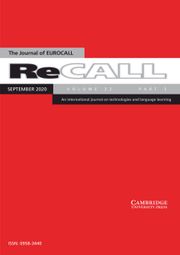Crossref Citations
This article has been cited by the following publications. This list is generated based on data provided by
Crossref.
Lin, M. H.
and
Lee, J.-Y.
2015.
Data-driven learning: changing the teaching of grammar in EFL classes.
ELT Journal,
Vol. 69,
Issue. 3,
p.
264.
Luo, Qinqin
Huang, Weizhen
and
Liao, Ying
2015.
Advances in Web-Based Learning -- ICWL 2015.
Vol. 9412,
Issue. ,
p.
37.
Curado Fuentes, Alejandro
2015.
Multiple Affordances of Language Corpora for Data-driven Learning.
Vol. 69,
Issue. ,
p.
177.
Mizumoto, Atsushi
and
Chujo, Kiyomi
2016.
Who is data-driven learning for? Challenging the monolithic view of its relationship with learning styles.
System,
Vol. 61,
Issue. ,
p.
55.
Mizumoto, Atsushi
Chujo, Kiyomi
and
Yokota, Kenji
2016.
Development of a scale to measure learners’ perceived preferences and benefits of data-driven learning.
ReCALL,
Vol. 28,
Issue. 2,
p.
227.
Cerezo, Luis
Caras, Allison
and
Leow, Ronald P.
2016.
THE EFFECTIVENESS OF GUIDED INDUCTION VERSUS DEDUCTIVE INSTRUCTION ON THE DEVELOPMENT OF COMPLEX SPANISHGUSTARSTRUCTURES.
Studies in Second Language Acquisition,
Vol. 38,
Issue. 2,
p.
265.
Luo, Qinqin
2016.
The effects of data-driven learning activities on EFL learners’ writing development.
SpringerPlus,
Vol. 5,
Issue. 1,
Glaser, Karen
2016.
News from the pragmatics classroom: Contrasting the inductive and the deductive approach in the teaching of pragmatic competence
.
Intercultural Pragmatics,
Vol. 13,
Issue. 4,
p.
529.
Vyatkina, Nina
2016.
Data-driven learning for beginners: The case of German verb-preposition collocations.
ReCALL,
Vol. 28,
Issue. 2,
p.
207.
Lin, Ming Huei
2016.
Effects of Corpus‐Aided Language Learning in the EFL Grammar Classroom: A Case Study of Students' Learning Attitudes and Teachers' Perceptions in Taiwan.
TESOL Quarterly,
Vol. 50,
Issue. 4,
p.
871.
Herrero, Rosana Dolón
and
Márquez, Miguel Fuster
2016.
Technology Implementation in Second Language Teaching and Translation Studies.
p.
91.
Larsen-Walker, Melissa
2017.
Can Data Driven Learning address L2 writers' habitual errors with English linking adverbials?.
System,
Vol. 69,
Issue. ,
p.
26.
Heift, Trude
and
Vyatkina, Nina
2017.
The Handbook of Technology and Second Language Teaching and Learning.
p.
26.
Ruivivar, June
and
Lapierre, Cynthia
2018.
Future-proof CALL: language learning as exploration and encounters – short papers from EUROCALL 2018.
p.
278.
Moon, Soyeon
and
Oh, Sun-Young
2018.
Unlearning overgenerated be through data-driven learning in the secondary EFL classroom.
ReCALL,
Vol. 30,
Issue. 1,
p.
48.
Heift, Trude
and
Caws, Catherine
2018.
Handbook of Research on Integrating Technology Into Contemporary Language Learning and Teaching.
p.
494.
Durand, Sally
2018.
Applications of CALL Theory in ESL and EFL Environments.
p.
131.
Pérez-Paredes, Pascual
and
Sánchez-Hernández, Purificación
2018.
Uptake of corpus tools in the Spanish Higher Education context: a mixed-methods study.
Research in Corpus Linguistics,
p.
51.
Leow, Ronald P.
2019.
ISLA: How implicit or how explicit should it be? Theoretical, empirical, and pedagogical/curricular issues.
Language Teaching Research,
Vol. 23,
Issue. 4,
p.
476.
Yao, Gang
2019.
Vocabulary learning through data-driven learning in the context of Spanish as a foreign language.
Research in Corpus Linguistics,
Vol. 7,
Issue. ,
p.
18.

